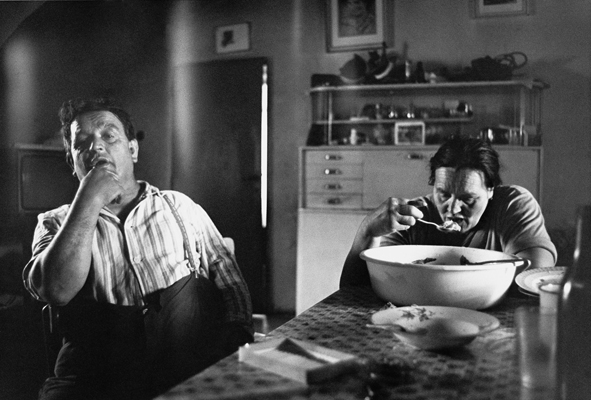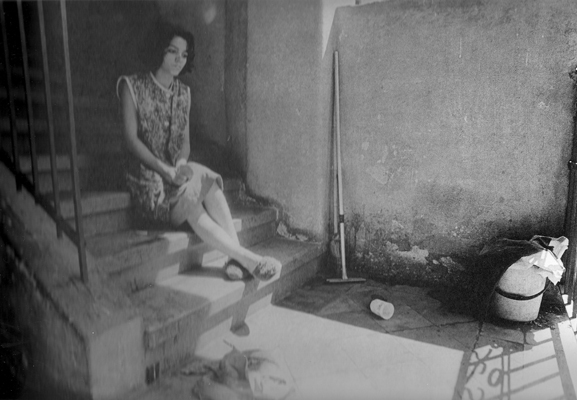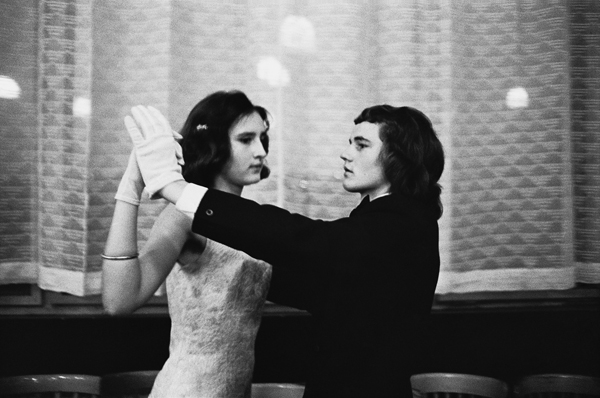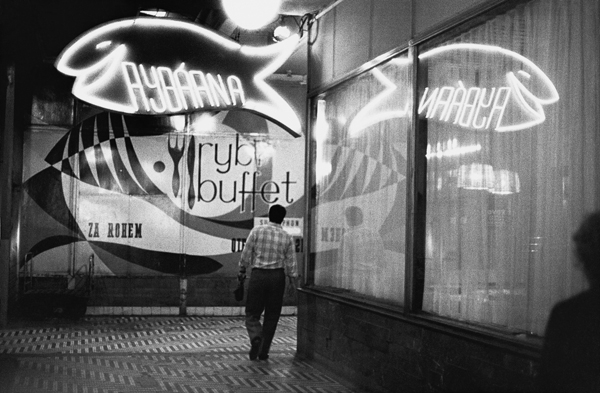Iren Stehli, Brigitte Weiss Galerie, Zurich, January 16, 2009 – March 7, 2009.
IREN STEHLI, BRIGITTE WEISS GALERIE, ZURICH. JANUARY 16, 2009 – MARCH 7, 2009
Iren Stehli, a Swiss native who was drawn to Prague by her interest in her mother’s heritage, first arrived there in 1974. At that time the city was in the midst of a difficult political period, the “normalization,” i.e., the return to the status before the Prague Spring. In Prague Stehli first studied Czech and decided to stay and study photography. Once enrolled in the Academy of Film, Photography, and Television (FAMU), still a bastion of some freedom of creative – if not political – expression, Stehli’s interests took a more concrete shape.
The photographs in this exhibition of Stehli’s work span most of her career, starting with an early series capturing a family of Czech peasants in A Farm in North Bohemia (1975) through her more recent photographs (Still Lifes) with their focus on domestic details, and the portraits of Libuna, a Czech Roma woman and her family. Each series was represented by one or two photographs, all about 20”x24”. As I was looking around, I found that the show was lacking context and a back-story – some of the photographs were beautiful formally, others seemed more like snapshots. There were the usual portraits of people, but also almost conceptual photographs of details such as a wall-shelf with a flowerpot, a cracked and deteriorating building wall, a store window, and then a dinner scene reminiscent of a Great Master’s still life study, but with a typical Eastern European meal.
Something about the photographs, as well as their eclectic assembly, drew me in. Maybe it was the recognition of some of the settings, the familiarity with some of the people. Seeing these photographs whet my curiosity and I started flipping through the pages of two books that were also on display, comprehensive anthologies of Stehli’s work. After seeing the books, I began to understand that Stehli was actually writing with these photographs. The exhibition would have been more impressive if it focused on only one series. This would have provided the viewer with the entire story that Stehli so deftly captured with her camera, and it would have allowed the narrative to evolve. I also found that the exhibited photographs were too small. When I read that in the late seventies, when Stehli had one of her first exhibitions in Czechoslovakia, she installed her work on almost human-scale, I imagined the impact, and understood how avant la lettre that was for that time, that country, and that gender.
Even in Stehli’s early work, one can already see a certain aesthetic that exists throughout her career – a keen interest in capturing the essence of her subjects, their unique qualities and the relationships they have with one another, their emotions and their environments, in grainy black and white photographs. In Libuna: a Gypsy’s Life in Prague, Stehli said “the cordiality of the people, but also the melancholia of the city and the often dreary everyday life in ‘real socialism’ left such a strong impression on me that I felt the need to respond, to photographically document what I saw.”
 Many of her photographs focus on the poverty and misery of the subjects’ lives, and yet also manage to accentuate their personalities, which she tries to elicit by allowing her subjects the freedom to sometimes choose their positions. Her series read like photo essays. Each image resembles a still from a film, an imaginary film of the lives of her subjects. In the series A Farm in North Bohemia, one particular photograph of a domestic kitchen scene brings to mind Stehli’s capacity to capture the transient moments of daily habit. The mother is eating from a large white bowl, looking down at her food while the father looks toward the camera as if in mid-thought. Light shines upon their faces from the right and a door stands slightly ajar in the background. This moment captures the simplicity of their lives and alludes to their relationship, not necessarily as an objective document, but rather as an archive of that instant which can never be recaptured.
Many of her photographs focus on the poverty and misery of the subjects’ lives, and yet also manage to accentuate their personalities, which she tries to elicit by allowing her subjects the freedom to sometimes choose their positions. Her series read like photo essays. Each image resembles a still from a film, an imaginary film of the lives of her subjects. In the series A Farm in North Bohemia, one particular photograph of a domestic kitchen scene brings to mind Stehli’s capacity to capture the transient moments of daily habit. The mother is eating from a large white bowl, looking down at her food while the father looks toward the camera as if in mid-thought. Light shines upon their faces from the right and a door stands slightly ajar in the background. This moment captures the simplicity of their lives and alludes to their relationship, not necessarily as an objective document, but rather as an archive of that instant which can never be recaptured.
For her Dancing Lessons series of 1974-1977, Stehli photographed young men and women at dancing halls, locations reminiscent of the interiors of Milos Forman’s early Czech films, especially The Loves of a Blond and The Fireman’s Ball. These cold and sad environments evoke no joy from the characters; rather, the men and women are photographed with mostly melancholy faces. Stehli’s style does not simply bring to mind the aesthetic of the Czech New Wave, but also of the European New Wave in general, in which film directors, like Truffaut and Godard, captured the material of daily life in a languid and unaffected, hyper-realistic fashion. The photographs reveal Czech culture in those years, with its socialist prudishness and morality, malaise and apathy, as well as its repressed desires. The Fast Food Fish series offers us a view of life during a time of economic plenty in Czechoslovakia, with restaurants and shops offering consumer goods. The portraits of the consumers, however, still reveal their gloom and sadness in a grey world of political and social repression.
In 1975, Stehli met a young gypsy woman, Libuna, who worked as a cleaning lady in her dorm in Prague, and the two started a friendship that would last over three decades. Stehli immortalized Libuna in a book that spans 25 years of life in Prague. The photographs in the book are beautiful meditations on life and its hardships, as well as the toll they took on Libuna’s physical well-being. Over the course of the book, Libuna raises her children and, in turn, helps them raise their own. She is the pillar of a family that grows in front of our eyes as we turn the pages of the book and become increasingly engrossed in her secrets, happiness and pain. Some of the photographs are snapshots of intimate moments: fights between Libuna and her husband Lada or Libuna preparing herself in the mirror in an extremely modest apartment. Libuna makes such an intriguing subject particularly because of her spirit and her bravery, which remain steadfast in the face of overwhelming hardships. The book is not merely a document of one woman’s life, but rather a testament to the fate of one family on the margins of society in Zizkov, a poor working class neighborhood of Prague.
 Stehli’s photographs of Libuna have remarkable emotional range. A photograph from the summer of 1979 shows Libuna, uncharacteristically alone, sitting on the steps of her soon-to-be demolished apartment building. In this moment, as one might expect, she is melancholy and pensive, the prospect of finding new lodgings for her family lying heavily upon her. Other photographs, however, offer comic relief and allow us to see that even in the most difficult of circumstances, life offers humor. In another photograph, the family leans over Prague’s famous Charles Bridge, looking down at the water. The symmetry is particularly striking for its charm and for the fact that, seen from this angle, these people could be anyone. All we see of these characters are the backs of their bodies, the girls’ skirts blowing in the wind, and the photograph as a whole seems reminiscent of Henri Cartier Bresson’s photographs in Paris.
Stehli’s photographs of Libuna have remarkable emotional range. A photograph from the summer of 1979 shows Libuna, uncharacteristically alone, sitting on the steps of her soon-to-be demolished apartment building. In this moment, as one might expect, she is melancholy and pensive, the prospect of finding new lodgings for her family lying heavily upon her. Other photographs, however, offer comic relief and allow us to see that even in the most difficult of circumstances, life offers humor. In another photograph, the family leans over Prague’s famous Charles Bridge, looking down at the water. The symmetry is particularly striking for its charm and for the fact that, seen from this angle, these people could be anyone. All we see of these characters are the backs of their bodies, the girls’ skirts blowing in the wind, and the photograph as a whole seems reminiscent of Henri Cartier Bresson’s photographs in Paris.
 Overall, the stills of Libuna’s life are hyperrealistic, cinematic, new wave-like snippets of life under an oppressive regime, with moments of happiness, dread and sadness, but mostly a struggle to continue to live with dignity. Stehli’s photographs capture everyday misery and banality and render her subjects extraordinary by treating them with respect and absenting herself of judgment or prejudice. Stehli’s greatest achievement is her rejection of an ideology that would have preferred to make Roma completely invisible. Instead, Stehli gives a face to those who have been rendered faceless in her representation of Libuna’s fortitude and self-sacrifice, as well as the prosaic nature of her daily life.
Overall, the stills of Libuna’s life are hyperrealistic, cinematic, new wave-like snippets of life under an oppressive regime, with moments of happiness, dread and sadness, but mostly a struggle to continue to live with dignity. Stehli’s photographs capture everyday misery and banality and render her subjects extraordinary by treating them with respect and absenting herself of judgment or prejudice. Stehli’s greatest achievement is her rejection of an ideology that would have preferred to make Roma completely invisible. Instead, Stehli gives a face to those who have been rendered faceless in her representation of Libuna’s fortitude and self-sacrifice, as well as the prosaic nature of her daily life.
Stehli’s photographs invite the viewer to participate in the lives of her subjects, and bear witness to the historic transition from communism to capitalism. They depict in minute and loving detail the impact these two systems have had on real people, their hardships, joys and community.






